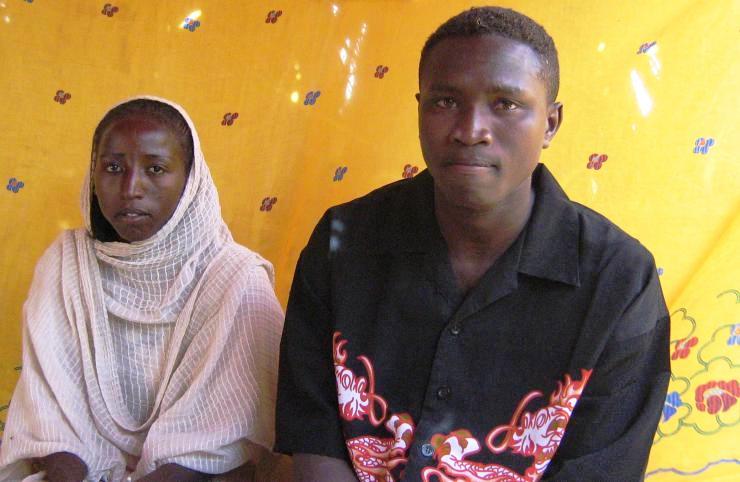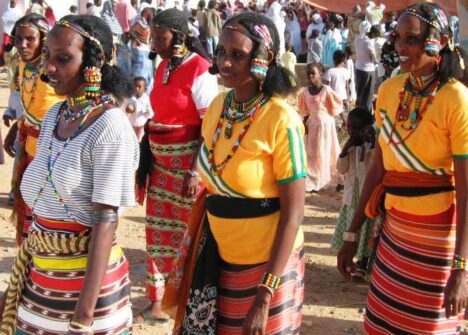The Celebration of Marriage.

After the initiation ceremony (Anfura-la) or the passage from adolescence to youth, the young Kunama sets out to find a girl to marry. This phase is also marked by some rites, such as that of engagement (Sussa-ma).
Among the Kunama, young people are free to choose the girlfriend they want and girls are equally free to accept the courtship or not. There are no external impositions.To the girl who agrees to marry, the young Kunama must, first of all, make a gift of a pair of sandals – preferably made by local artisans – a piece of white rough canvas (dalasesa) with decorative coral (dada).

Among the Kunama, young people are free to choose the girlfriend they want and girls are equally free to accept the courtship or not.
In the event that the two fail, for various reasons, to get married within the year, the gesture of the delivery of the gifts is repeated every year, confirming the engagement is still in progress.
The rite of Toba
A month before the wedding, the Toba-Iausa rite is celebrated (the Toba is a hatchet with no handle). In the boyfriend’s house, one of the family takes the axe and wraps it in a piece of rough white cloth, which will then be used by the girlfriend to cover her chest during the wedding celebration – according to custom, Kunama women always go bare-breasted – and tie the bundle with palmadum leaves (Iaca) or with intertwined baobab fibres kept first in a container of water, to which a few drops of goat or cow’s milk are mixed according to the clan to which the girl belongs.
The Toba prepared in this way is delivered to four people chosen as witnesses (two women and two men already regularly married and with their firstborn still alive). The rite is intended to be a wish for the two young people who are about to get married so that they can have a healthy family and many children.

Kunama, a young lady.
At the end of this ceremony, the Toba is placed in a corner of the house and two or four days later, at nightfall, two people will take responsibility for taking it to the girlfriend’s house. Delivery takes place in complete silence; only the gestures of the protagonists find a proper emphasis.
The person carrying the Toba presents himself on the doorstep, kneeling or prostrate, and hands the wrapper, through the semi-closed door, to the girl’s father or uncle inside the house. The gesture, of course, is repeated two or four times and indicates the consent of the relatives to the upcoming celebration.
The wedding day
Finally, the wedding day arrives. During the celebration, the groom and a friend of his, the bride and a friend of hers, at the proper moment stand in single file. Another person takes a ritual goat and circles the group four times. After the first two laps, if any of the four are from the lasha-cuta, they leave the line and step over the animal twice. After the other two laps also the remaining ones, belonging to the aira-cuta, step over the goat four times. The rite, simple and short, has a very specific importance: it serves to recognize and declare the virginity of the bride or not. That is, after the usual two or four rounds, the girl is called to step over the goat, but she can do so only if she is still a virgin; otherwise, she simply has to go around the animal. If the girl claims to be a virgin, those present celebrate her with trills of joy and wishes for a happy marriage. And the parents acquire the right to ask the groom’s family for an increase in the price of the dowry (collikinga).

Among the Kunama, it is inconceivable that a girl remains a virgin for life. She has to become a mother.
The ceremony, however, does not end here. The goat is killed and a rib joined to the sternum is given to the groom; the young man, to indicate that he has never abused the girl, must break the breastbone. If, on the other hand, he had had relations, he must absolutely abstain from the operation. As for the girl, the fear of misfortune is an excellent truth serum. Among the Kunama, it is inconceivable that a girl remains a virgin for life. She has to become a mother. Sterility, in fact, is considered a curse, a punishment. If the woman becomes pregnant out of wedlock, she must ask for the mandatory celebration of the mashkabara sacrifice. During this celebration, an ox (mashkabara) is sacrificed and consumed and the man held responsible for the pregnancy is forced to pay a fine. After the ceremony, everyone can return to their daily occupations.
Unlike other ethnic groups in Eritrea, in the Kunama, the bride and groom spend their honeymoon at the home of the bride’s parents. This is to ensure that the bride receives excellent care from her family. Three days after the wedding, the bride and groom receive gifts called Anjiba Teda. The bride’s father and uncles offer cattle to the new bridegroom.
The Kunama today
The Kunama are the smallest ethnic group in Eritrea. A people that has always suffered and been marginalised throughout its history. Relations between the Kunama and the government of Eritrea have been tensed since the country’s independence in 1993. Kunamas have accused the Eritrean government of expropriating Kunama land for the resettlement of Eritrean refugees from Sudan. Over the years have been several incidents with the death of Kunama people.

During the recent conflict in 2022 between the Addis Ababa government and the Tigray regional government, the Kunama were targeted by Eritrean forces, Ethiopian forces and Amhara special forces and militias.
During the Ethiopian- Eritrean war of 1998-2000, they were caught in the middle, and many were displaced. Clan leaders and influential Kunama politicians were missing and never seen again.
Once again, during the recent conflict in 2022 between the Addis Ababa government and the Tigray regional government, the Kunama were targeted by Eritrean forces, Ethiopian forces and Amhara special forces and militias. Kunama settlements in Tigray were burnt by Eritrean troops. The troops destroyed their property and looted their livestock. Many Kunama are now internally displaced after fleeing their homes at the start of the conflict.
Ayana F. Makda



